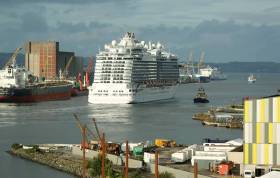Displaying items by tag: 117 calls
#CruiseLiners - According to Cruise Belfast 2018 will be another record cruise season for Belfast Harbour with 117 ships expected to dock in the city bringing more than 200,000 visitors to Northern Ireland.
25% more ships are booked to arrive in Belfast Harbour compared to last year including, eight new Cruise Lines which have added Belfast to their itineraries, joining the cruise industry’s leading operators Carnival, Royal Caribbean and Cunard. The City is also becoming increasingly popular with ‘Exploration and Adventure’ ships which operate at the luxury end of the market.
More than half of the ships calling will each bring over 1,000 visitors to Belfast with the largest ship, the 330m long Royal Princess, bringing more than 61,000 passengers to the City during her 12 calls. August will be the busiest month with 26 cruise calls bringing over 40,000 passengers and crew.
Among the new lines calling is Swiss-based Viking Line which has recently diversified into ocean going cruising having previously concentrated on the popular European river cruise market. Viking Line has scheduled four calls to Belfast in 2018 bringing almost 6,000 visitors in total. Other first time callers include ‘mega-yacht’ operator Variety Cruises, who are scheduled to call ten times this summer.
The length of Belfast’s cruise season has also extended with the first call due in mid-March and the last call in mid-October. For the first time it’s expected that passenger and crew numbers to Belfast will break the 200,000 mark, up almost 50,000 in a year.
By the end of the season Belfast Harbour will have welcomed over 700 ships and 1.2M cruise visitors since the first cruise ships visited the Port in 1996.
Details of the cruise schedule can be found on Belfast Harbour’s website www.belfast-harbour.co.uk/cruise-schedule/





























































